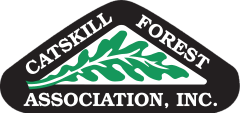WHAT’S GOING ON IN THE FOREST?
I live in Samsonville, central Ulster County, that was hit hard by the emerald ash borer earlier than other areas of the Catskills. Most of the time, ash is a smaller component of the forest; Roughly 4 to 10%. However, in some areas on a smaller scale it can be dominant. This photo shows what an area looks like that is filled with dying ash. The “losers” are obviously the unfortunate ash trees. You can’t really tell by the photo, but the “winners” are mostly sugar maple and some red oak. The understory is coming in with multiflora rose, sedges and Japanese stiltgrass. Unfortunately, this opening isn’t large enough to overwhelm the deer’s appetite for upcoming or regenerating vegetation; Only the least palatable plants survive (stiltgrass and things with barbs like multiflora rose). This condition can leave Foresters scratching their heads on what to do. Do you cut harder and leave more coarse woody debris in order to provide an obstacle coarse for deer, or do you treat chemically? Like most things, it depends. In the meantime, something will grow, but the forest will be different.
Ryan Trapani
Director of Forest Services
Catskill Forest Association
